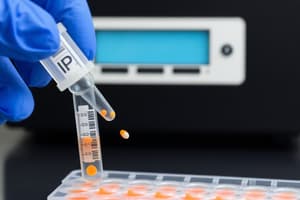Podcast
Questions and Answers
What is a crucial step in preventing Salmonella contamination related to food handling?
What is a crucial step in preventing Salmonella contamination related to food handling?
- Using the same cutting board for raw and cooked foods
- Promptly refrigerating leftovers (correct)
- Marinating raw meat for longer duration
- Thawing frozen seafood at room temperature
What is one of the most common causes of gastroenteritis?
What is one of the most common causes of gastroenteritis?
- Salmonella (correct)
- E. coli
- Campylobacter
- Listeria
When is regular handwashing with soap and water essential to prevent Salmonella infection?
When is regular handwashing with soap and water essential to prevent Salmonella infection?
- After handling raw meat (correct)
- Before drinking water
- Before going to bed
- After watching television
What can significantly reduce the risk of Salmonella infection?
What can significantly reduce the risk of Salmonella infection?
What is recommended to prevent the spread of Salmonella during food preparation?
What is recommended to prevent the spread of Salmonella during food preparation?
Which type of bacteria can cause foodborne illness in humans?
Which type of bacteria can cause foodborne illness in humans?
What is a common symptom of Salmonella infection?
What is a common symptom of Salmonella infection?
How soon do the symptoms of Salmonella infection typically appear after exposure to the bacteria?
How soon do the symptoms of Salmonella infection typically appear after exposure to the bacteria?
What can increase the risk of Salmonella infection according to the text?
What can increase the risk of Salmonella infection according to the text?
What is a potential consequence of Salmonella infection if not managed properly?
What is a potential consequence of Salmonella infection if not managed properly?
How long does the illness caused by Salmonella infection typically last?
How long does the illness caused by Salmonella infection typically last?
What can lead to widespread Salmonella contamination in food products according to the text?
What can lead to widespread Salmonella contamination in food products according to the text?
Which of the following is a common route of Salmonella transmission mentioned in the text?
Which of the following is a common route of Salmonella transmission mentioned in the text?
Which of the following is an effective method for eliminating Salmonella according to the text?
Which of the following is an effective method for eliminating Salmonella according to the text?
Flashcards are hidden until you start studying
Study Notes
Salmonella: Understanding Prevention, Symptoms, and Transmission
Salmonella is a type of bacteria that can cause foodborne illness in humans. It is one of the most common causes of gastroenteritis, with symptoms ranging from mild to severe. In this article, we will explore the prevention and control measures for Salmonella, its infection symptoms, and the various transmission routes.
Salmonella Prevention and Control Measures
Preventing Salmonella infection involves several key measures, primarily focused on food safety and personal hygiene. Here are some important steps to prevent and control Salmonella:
-
Safe Food Handling: Properly cooking and storing food is crucial in preventing Salmonella contamination. It is important to cook poultry, ground beef, and eggs thoroughly to kill any bacteria present. Additionally, leftovers should be promptly refrigerated.
-
Handwashing: Regular and thorough handwashing with soap and water is essential, especially after handling raw meat, using the bathroom, or changing diapers. This simple practice can significantly reduce the risk of Salmonella infection.
-
Avoiding Cross-Contamination: Keeping raw meat, poultry, and seafood separate from other foods during storage and preparation can prevent the spread of Salmonella. Using separate cutting boards and utensils for raw and cooked foods is recommended.
-
Proper Hygiene for Pets: Salmonella can be present in the feces of animals, so it is important to practice good hygiene when handling pets, especially reptiles, birds, and small mammals.
-
Avoiding Unpasteurized Products: Consuming unpasteurized milk, cheese, and juices can increase the risk of Salmonella infection. It is advisable to choose pasteurized products to minimize the risk.
-
Regular Cleaning: Thoroughly clean kitchen surfaces, utensils, and appliances to prevent the spread of bacteria. Using hot, soapy water is effective in eliminating Salmonella.
Salmonella Infection Symptoms
The symptoms of Salmonella infection typically appear 6 to 48 hours after exposure to the bacteria. Common signs and symptoms include:
-
Diarrhea: This is often the first symptom of Salmonella infection and can be accompanied by blood in the stool.
-
Abdominal Cramps: Severe abdominal cramps and pain are common and can be quite distressing.
-
Fever: A high temperature is a typical symptom of Salmonella infection and may indicate a more severe case.
-
Nausea and Vomiting: These symptoms often accompany diarrhea and can lead to dehydration if not managed properly.
-
Headache and Body Aches: Some individuals may experience headaches and generalized body aches during the course of the illness.
In most cases, the illness lasts 4 to 7 days, and most people recover without treatment. However, in severe cases, the infection may spread from the intestines to the bloodstream and other parts of the body, requiring medical attention.
Salmonella Transmission Routes
Salmonella bacteria are commonly transmitted through several routes, including:
-
Contaminated Food: Consuming contaminated food, particularly raw or undercooked eggs, poultry, and meat, is a common route of Salmonella transmission. Additionally, unwashed fruits and vegetables can also harbor the bacteria.
-
Cross-Contamination: When juices from raw meat or poultry come into contact with ready-to-eat foods, cross-contamination can occur, leading to Salmonella infection.
-
Animal Contact: Handling reptiles, birds, and other animals, especially in settings such as petting zoos, can increase the risk of Salmonella transmission.
-
Improper Food Handling: Food prepared by an infected individual who did not wash their hands properly after using the bathroom can lead to contamination and subsequent transmission.
-
Unsanitary Conditions: Poor hygiene in food production and processing facilities can lead to widespread Salmonella contamination in food products.
Understanding these transmission routes is crucial in implementing effective preventive measures to reduce the incidence of Salmonella infections.
In conclusion, Salmonella prevention and control measures revolve around safe food handling, personal hygiene, and sanitation practices. Recognizing the symptoms of Salmonella infection and understanding its transmission routes can empower individuals to take proactive steps in minimizing the risk of illness. By implementing these measures, the incidence of Salmonella infections can be significantly reduced, contributing to a healthier and safer community.
Studying That Suits You
Use AI to generate personalized quizzes and flashcards to suit your learning preferences.




